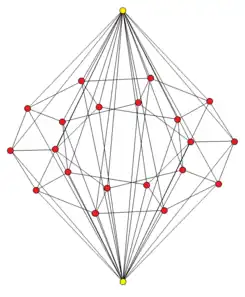| Decahedral bipyramid | ||
|---|---|---|
 Ortogonal projection The 20 central dodecahedron vertices are shown in red, with 2 apex vertices in yellow. | ||
| Type | Polyhedral bipyramid | |
| Schläfli symbol | {5,3} + { } dt{2,3,5} | |
| Coxeter-Dynkin | ||
| Cells | 24 {5}∨{ } | |
| Faces | 60 Isosceles triangles 12 pentagons | |
| Edges | 70 (30+20+20) | |
| Vertices | 22 | |
| Dual | Icosahedral prism | |
| Symmetry group | [2,5,3], order 240 | |
| Properties | convex, isochoric | |
In 4-dimensional geometry, the dodecahedral bipyramid is the direct sum of a dodecahedron and a segment, {5,3} + { }. Each face of a central dodecahedron is attached with two pentagonal pyramids, creating 24 pentagonal pyramidal cells, 72 isosceles triangular faces, 70 edges, and 22 vertices. A dodecahedral bipyramid can be seen as two dodecahedral pyramids augmented together at their base.
It is the dual of a icosahedral prism.
See also
References
External links
This article is issued from Wikipedia. The text is licensed under Creative Commons - Attribution - Sharealike. Additional terms may apply for the media files.